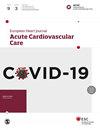Clinical characteristics and prognosis of patients with infective endocarditis admitted to a coronary unit in a hospital with cardiac surgery
IF 4.6
2区 医学
Q1 CARDIAC & CARDIOVASCULAR SYSTEMS
European Heart Journal: Acute Cardiovascular Care
Pub Date : 2024-05-09
DOI:10.1093/ehjacc/zuae036.123
引用次数: 0
Abstract
Funding Acknowledgements None. Introduction Cardiac critical care units are essential for the management of complicated infective endocarditis (IE). Objective We set out to analyze the baseline characteristics, clinical complications and prognosis of patients with IE admitted to a Coronary Care Unit (CCU), as well as to compare them with patients admitted to hospital wards. Material and Methods Prospective, single-centre, observational study including patients who were diagnosed of IE from 2016-2022 and admitted in a hospital with cardiac surgery. They were classified into two groups according to whether or not they were admitted to the CCU. We collected data on microbiological isolation, cardiac and systemic complications as well as in-hospital mortality. Patients were followed long-term for cardiovascular (CV) and all-cause mortality, readmission and IE recurrence. All variables (qualitative) were compared by Chi-square test and overall mortality was compared in both groups by the LogRank test. We established a significance level of p<0.05. Results From a total of 162 patients with a median age of 68 years (IQR 68), 28.4% (46) were admitted to the CCU. These patients were similar in age to those not admitted (mean 65 vs 66 years, NS), but had a higher percentage of diabetics (47.8 vs 27.6%, p=0.01). The most frequent previous heart disease in both groups was valvular heart disease. The most frequently isolated microorganisms in CCU patients were Staphylococcus aureus (46.4%) and Streptococcus epidermidis (37.9%) which, in our series, produced the highest percentage of shock (35.7% and 23.3% respectively) in a statistically significant way (p<0.01), with the need for noradrenaline (60.9%) and dobutamine (28.3%); no ventricular assist devices were used. Critically ill patients had a higher incidence of atrioventricular block requiring a permanent pacemaker (32.6% vs 4.3%, p<0.01), valve dysfunction (76.1% vs 55.2%, p=0.014) and were more frequently operated than those admitted to the ward (56.%% vs 38%, p=0.04). Among all IE patients, 24.6% died during admission, most of them (15.7% of the total) were admitted to the coronary unit (p<0.01). In our 36-month mean follow-up, we found significantly higher readmission rates in the CCU group (36.6% vs. 15%, p<0.01), unrelated to IE recurrences. The critically ill group exhibited a higher mortality rate due to cardiovascular disease and all-cause causes (43.5% vs 15.9%, p0.01; 63% vs 23.9%, p0.01). In the CCU group there is significantly lower survival (mean 65 vs 37 months, LogRank p<0.01) with respect to the hospital ward group. Conclusion Our CCU is responsible for treating patients with IE that is highly complex and that progresses poorly, with a higher frequency of shock and in-hospital mortality, which leads to a decreased prognosis during follow-up. Anticipating complications and collaborating with cardiac surgery is essential to improve clinical outcomes.一家心脏外科医院冠状动脉科收治的感染性心内膜炎患者的临床特征和预后
无。导言:心脏重症监护病房是治疗复杂感染性心内膜炎(IE)的重要场所。目的 我们旨在分析入住冠心病监护病房(CCU)的 IE 患者的基线特征、临床并发症和预后,并将其与入住医院病房的患者进行比较。材料与方法 前瞻性、单中心、观察性研究,包括2016-2022年期间被确诊为IE并入住心脏外科医院的患者。根据是否入住 CCU,将他们分为两组。我们收集了有关微生物分离、心脏和全身并发症以及院内死亡率的数据。我们对患者进行了长期随访,以了解心血管(CV)和全因死亡率、再入院和 IE 复发情况。所有变量(定性)通过卡方检验进行比较,两组患者的总死亡率通过 LogRank 检验进行比较。我们设定的显著性水平为 p<0.05。结果 在中位年龄为 68 岁(IQR 68)的 162 名患者中,28.4%(46 人)住进了 CCU。这些患者的年龄与非住院患者相似(平均 65 岁对 66 岁,NS),但糖尿病患者的比例更高(47.8% 对 27.6%,P=0.01)。两组患者最常见的心脏病都是瓣膜性心脏病。CCU患者中最常分离出的微生物是金黄色葡萄球菌(46.4%)和表皮链球菌(37.9%),在我们的系列研究中,这两种细菌导致休克的比例最高(分别为35.7%和23.3%),具有统计学意义(p<0.01),需要使用去甲肾上腺素(60.9%)和多巴酚丁胺(28.3%);没有使用心室辅助装置。重症患者中需要永久起搏器的房室传导阻滞(32.6% vs 4.3%,p<0.01)和瓣膜功能障碍(76.1% vs 55.2%,p=0.014)的发生率较高,而且比病房住院患者更常接受手术(56.%% vs 38%,p=0.04)。在所有 IE 患者中,24.6% 的患者在入院期间死亡,其中大部分(占总数的 15.7%)是在冠状动脉科入院的(p<0.01)。在为期36个月的平均随访中,我们发现CCU组的再入院率明显更高(36.6%对15%,p<0.01),这与IE复发无关。重症组患者因心血管疾病和全因死亡率更高(43.5% 对 15.9%,p0.01;63% 对 23.9%,p0.01)。与病房组相比,CCU 组的存活率明显较低(平均 65 个月对 37 个月,LogRank p<0.01)。结论 我们的CCU负责治疗病情高度复杂、进展缓慢的IE患者,休克和院内死亡率较高,导致随访期间预后下降。预测并发症并与心脏外科合作对改善临床预后至关重要。
本文章由计算机程序翻译,如有差异,请以英文原文为准。
求助全文
约1分钟内获得全文
求助全文
来源期刊

European Heart Journal: Acute Cardiovascular Care
Medicine-General Medicine
CiteScore
8.50
自引率
4.90%
发文量
325
期刊介绍:
The European Heart Journal - Acute Cardiovascular Care (EHJ-ACVC) offers a unique integrative approach by combining the expertise of the different sub specialties of cardiology, emergency and intensive care medicine in the management of patients with acute cardiovascular syndromes.
Reading through the journal, cardiologists and all other healthcare professionals can access continuous updates that may help them to improve the quality of care and the outcome for patients with acute cardiovascular diseases.
 求助内容:
求助内容: 应助结果提醒方式:
应助结果提醒方式:


